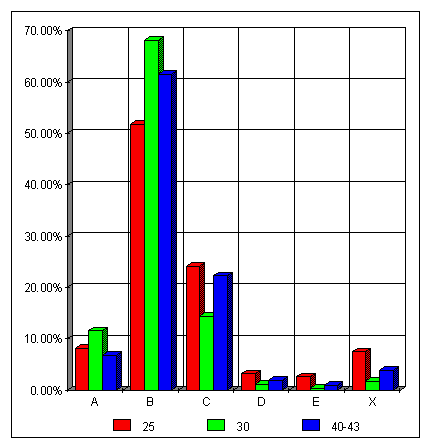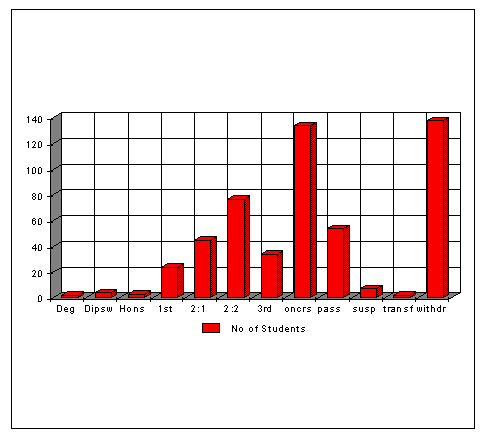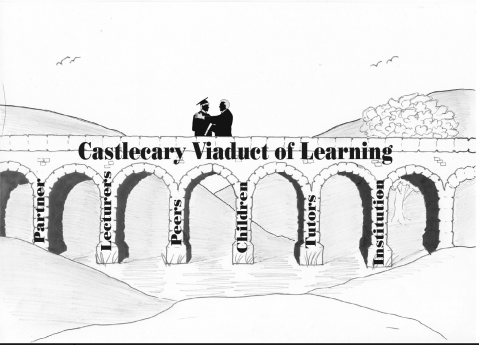
This paper concerns research into the performance and progression of former Access students having pursued a one year Access course chiefly in the FE sector. It examines the performance of students in three universities, and one Further Education College (this last group studying HN courses), all in west or central Scotland. It further seeks to review the progress of 650 former Access students studying across many different FE colleges studying HNC, HND or other advanced courses. In its first phase, the research sought to establish trends of performance in these former Access students. In the second phase of the research, an attempt was made to suggest a model which may explain variations in performance.
The first phase consisted of mainly a statistical analysis of former Access students in three universities in comparison with all students from whatever entry mode. Performance was examined by comparing the grades obtained in examinations of students from various entry modes to determine any identifiable trends. An indication of the initial findings from this study is demonstrated by an analysis of the exam results in one academic year (1994) of all students at whatever stage in their studies in that academic year. Viewing this cohort at the University of Stirling displaying the results of students from various modes of entry we find the following:

Code 25 represented the former Access students, Code 30 the A-level entry students and codes 40-43 SCE entries. In looking at the performance profile of Access students it would appear to be broadly similar to the performance SCE profile. The Access students were less likely to obtain a B grade and more likely to obtain a C. Also we note that they were just as likely to obtain an A pass as the SCE students were. The only other difference of note was again in the area of “X” grades or non-completions. The Access had double the rate of non-completions or "X" grades.
On examining available data from a different university, one was struck immediately by the variability in quality of available data. In this case, I was permitted only to see some limited information on the progress of five hundred and twenty six former Scottish Wider Access Programme (SWAP) students who had progressed to study at this university in the West of Scotland over a five year period.
Summarising the results it was noted that 243 of these students received some kind of award (46.2%), whilst 138 had withdrawn from the university (26.2%). Of the remaining 145, 134 were on course (25.5%) and the few remaining were made up of those who had transferred to other universities or had had their studies suspended. However we note that the percentage of withdrawals (26.2%) was high.
2.2 
Although the above results may be termed as interesting they did not significantly add to an understanding of the processes or factors which affect performance and progression.
Another phase of the research examined the records of various named former Access students determining the success rates of these students who had been identified as leaving Access and pursuing Higher National (HN) study in Further Education Colleges. Of the 650 students reported by SCOTVEC it was found that 186 had gained no award. (SCOTVEC has now been superseded by SQA.)
There were a further 190 who had no group award recorded but however were described as ‘On Course’. It was stated that SSOTVEC did not have any clear criteria for removing a student from the list. There were no clear parameters available for when a student may be considered as having lapsed and therefore failed to achieve a group award.
This left a total of 274 students out of the 650 who had already gained some kind of group award. It was noted that this represents some 42% of the original population.

It would be of further interest to compare this level of performance with other student groups, for example those who entered with SCE or A-level qualifications. If the performance of former Access students in pursuing Higher National level study is significantly lower than the success level of all students in this level of study then the picture presented in HN level study is different from that which is suggested in degree study. SCOTVEC stated that ‘award rates have been published with the annual reports until 1990. After that they have remained confidential.’ The following were the last published award rates by SCOTVEC.
| HNC | HND | |
| 1986-87 | 63.8% | 65.6% |
| 1987-88 | 64.6% | 67.4% |
| 1988-89 | 65.5% | 63.8% |
| 1989-90 | 66.4% | 63.9% |
These figures are remarkably static throughout the period. In comparison with the 42% success level in Access, this would represent a substantial drop in success rate from the inferred global figures of somewhere in the low to mid sixties percent successful. It was decided to approach the Scottish Office Education and Industry Department requesting information concerning the success rates of students studying HNC's and HND's in Scotland. In the following tables the cumulative percentage pass rate is quoted and we can see this rising as time since the beginning of study elapses.
Table B
| cum | cum | |||
| HNC | %pass | HND | %pass | |
| 1992-93 new enrolments | 14,710 | 10,034 | ||
| Award gained 1992-93 | 7,257 | 49.3 | 2,844 | 28.3 |
| Award gained 1993-94 | 129 | 50.2 | 12 | 28.5 |
| Award gained 1994-95 | 3,900 | 76.7 | 3,382 | 62.2 |
| Award gained 1995-96 | 682 | 81.4 | 483 | 67.0 |
| Award gained 1996-97 | 249 | 83.1 | 103 | 68.0 |
Table C
|
cum |
cum | |||
| HNC | %pass | HND | %pass | |
| 1993-94 New Enrolments | 9,581 | 7,237 | ||
| Award gained 1993-94 | 4,753 | 48.2 | 1,162 | 16.1 |
| Award gained 1994-95 | 3286 | 83.9 | 2995 | 57.4 |
| Award gained 1995-96 | 521 | 89.3 | 438 | 63.3 |
| Award gained 1996-97 | 74 | 90.1 | 47 | 64.1 |
These global figures now provide an adequate basis on which to compare the success rates of the 650 students who left Access programmes with all other students. It is noticeable that the global figures for percentage success in HN programmes is substantially higher than the 42% success rate gained by the former Access students even though it may be pointed out that these courses could arguably be regarded as less rigorous than the degree courses studied earlier in the universities cited.
The performance and success figures for former Access students seem to vary greatly across universities and across sectors. It appeared that further quantitative research may not identify factors affecting these variations. A review of literature was engaged in an attempt to uncover a model that would explain these variable rates of performance and progression. This led to the following hypothesis concerning important underlying factors affecting performance particularly among these mature students.
The Castlecary Viaduct of Learning: A Model.
Figure 4.

Between Cumbernauld College, a further education college and the University of Stirling, at Castlecary is a viaduct carrying the train line from Glasgow through Stirling to Dundee. In this instance it can be looked upon as symbolic of the learning process that students en route to the University experience. The viaduct represents a supported pathway for learning. The train would have much greater difficulty crossing the valley without the aid of the viaduct. But the train line must be supported if it is to bear the train. Like a viaduct, learning requires to be supported by strong pillars.
In this analogy each pillar of the viaduct represents a support mechanism which the student requires if meaningful learning is to be experienced. What are these pillars? Linden West (1996) described a pilot project in which he examined the effect of relationships in the life of the student on the learning process. He writes, ‘We were to focus on the management of change; the role of significant others in the past and present; social situatedness and feelings of marginality; and the impact of education on motive and feelings about self over time.’ (‘Beyond Fragments’ p25.) West postulated that relationships have a profound affect on the learning process. It is clear that they will markedly affect the emotional and psychological climate in which the learner operates and thus affect the outcome. How does the change of identity in the learner affect existing relationships? Is the change of identity encouraged and supported, or is it resisted and opposed? And what about new relationships formed within the learning environment? Is the learner accepted in this new identity and does that sense of acceptance reinforce his/her self-identity? New social affiliations will tend to be supportive. A lack of affiliations will tend to act as a disincentive to learning. If the student feels marginalized, then the sense of identity as a learner will be threatened. What are the most relevant factors? I would suggest the following:
1. Peer group support: If the student is to adjust to his/her new identity it will be with the assistance of a network of other learners. These will provide a social context in which the transformation of identity can take place. This was noted with particular reference to mature women students in Edwards (1993). These were spoken of as ‘supportive’ relationships. Packham and Miller (2000) examined the effects of peer-assisted learning support on students at the University of Glamorgan during the 1997/98 academic year. The result of this interaction between the student and his/her peers is to foster learning networks which enhance the learning experience.
2. Partner/spouse support: The next pillar in the viaduct of learning is the student’s partner. If he/she is antagonistic to this new identity, then grave difficulties will be experienced and this may result in a disruption either to the pattern of study, or to the relationship, or both. Merrill (1999: p 120) quotes the work of Leonard in 1994 in dealing with mature women students in saying that one third of the mature women she interviewed in her study ‘met with considerable resistance from husbands over their decision to return to education.’ Clearly opposition from partners may be a huge negative influence and a supportive attitude a significant resource. Edwards (1993) described family and education as “greedy institutions” which demand so much from the student that there are bound to be conflicts between them. Some spoke of partners helping them to revise, reading essays and dissertations before presentation, and listening to and commenting upon their seminar papers before presentation. To be able to share their learning experiences at home leads to their being able to connect their educational identity with their domestic identity and may lead to feelings of greater integration within the student. If this is not possible, it means that these two identities are left disjointed and disparate and this results in feelings of non-integration.
3. Children/parent support: For the younger student the area of parental support may be enormously important, financially, psychologically and emotionally. However we must consider the effect of children on student parents. This is sometimes thought of in the negative sense. i.e. parents who are students will have a division of attention between their studies and the needs of their children. Whilst this is true, several nursing students in one study cited encouragement from children as a major positive factor encouraging them to complete their studies. Edwards in her study with mature women students said that children were spoken of generally as ‘supportive’. Of course, some children may well resent time spent away from seeing to their needs to pursue educational goals. Some students saw the fulfilling of educational goals as becoming a good role model for the children.
In Edwards (1993) half of the women studied said that they felt that their parents were pleased that they were doing something to improve their life chances and this would be signalled by their willingness to tell people proudly about what the women were doing. This is seen as reinforcing the new sense of identity as a learner. A negative parental experience will serve as yet another barrier to learning and an undermining of the new sense of identity as learner.
4. Institutional support: Another important concept is that of the creation of an institutional learning environment, a culture which is sympathetic and welcoming to the mature student, and thus supportive of the significant identity transformation required. A positive initial contact is important to adults returning to education. These messages will be taken to heart by the prospective student as he/she wrestles with the identity transformation. Does the institution accept the new me, the learner? That I’m changed from housewife and carer to learner in higher education, from unemployed or redundant worker to higher education student? (McGivney 1993). Dorman (2000) comments on the importance of the quality of the learning environment in determining the quality of the learning achievable. In its review of teaching in British universities, the Polytechnics and Colleges Funding Council (1990) asserted that the ethos of the whole institution largely determines the student’s experience and that this notion of institutional ethos is an important contributory factor to quality in higher education institutions. The ethos of the department, faculty or institution provides part of the learning environment and the student’s relationship to the institution will provide an important support structure in the learning experience.
5. Staff tutor’s support: Perhaps the most obvious interface between the student and learning is in lectures, seminars, tutorials, labs and the like. There is a need for the teaching staff to be supportive of the student. If an institution will provide supportive tutors then the learner will experience this pillar of support. The contrast between the findings of Merrill (1999) and Edwards (1993) is marked. Merrill speaks of the relationship being friendly and learners being satisfied with the support and contact that they had received from tutors. Whilst Edwards speaks of learners seeing lecturers as being different people from themselves and hence unapproachable. This presence or absence of the sense of relationship existing between student and lecturing staff has an effect on the sense of acceptance and hence the sense of self-identity that the student has. Acceptance leads to ease of identity transformation and non-acceptance to feelings of unease and disquiet and hence a greater probability of non-progression and non-retention.
6. Personal Tutor support. Finally we come to what in Access context was referred to as the guidance tutor. It has been observed that this close personal tutor relationship is not so prevalent in university. At the study in Warwick University (Merrill, 1999) it was noted that mature students were more likely to need to discuss situations with a personal tutor, and several of the mature students in the study underwent varying levels of personal and study problems. Because of age, life experiences, relationship or familial responsibilities, mature students’ capacity for more complex personal problems are greater than younger students. This highlights the higher level of need for supportive relationships with personal tutors which will sustain them through the stormy seas.
This six fold support hypothesis has now begun to be tested by interviews and though this process at time of writing is not complete, certain conclusions and trends have been noted.
At the beginning of interviews, students were invited to help create a Learning World Map. A blank sheet of A3 paper was provided with a labelled disc in the centre bearing the legend ‘ME.’ Learners were instructed then to place on this map further discs which indicated others who have an effect on their learning, either positive or negative. The only instruction given was that if the effect was a strong effect then the disc should be labelled and put close to the centre and if the effect was peripheral then the placing should be peripheral. The following observations can now be made:
1. Not one student mentioned the academic advisor (year advisor, advisor of studies, guidance tutor) as being a significant relationship. Not one student placed this individual on the Learning World Map, and when questioned about it students stated that this individual simply rubber stamped their choices of units of study and had no other function. This would suggest that a change in the hypothesis is required in deleting this individual as having any significant effect in the learning of mature students.
2. There was universal agreement that the relationship with lecturing staff was immensely important. Some spoke of thinking of the lecturers as “unapproachable gods” on day 1, but later found establishing a supportive relationship and rapport with the lecturer as immensely important in facilitating learning. It permitted invaluable questioning and dialogue which enhanced the learning experience.
3. With reference to partner support, responses ranged from those with no partner, to those whose partner supported them financially but in no other way, to those who were almost ideal. This last group described partners who provided practical help in domestic duty sharing and moral support, read essays, listened to presentations and gave limited support in terms of discussing learning (though that was limited by inability to understand all of the technical aspects of the learning).
4. In terms of lecturer support, the picture varied from university to university and from department to department. Some departmental cultures were clearly more supportive than others. However there was good agreement that students in general considered that where there was some sense of relationship, that the quality of learning was enhanced.
5. Views on institutional culture also varied from fairly positive views to those who expressed that they were just a number whose chief purpose was to bring in funding for the university.
6. Several learners emphasized the immense importance of peer relationships as a supportive influence in their learning. Bottom-up rather than top-down study groups, informally devised were mentioned in a number of occasions. Sometimes these were focussed on mature students gathering together, drawn together by sharing similar challenges and problems, whilst some spoke of study groups which spanned the age divide. Those who expressed that they did not form relationships with other students, were also amongst those who expressed the greatest dissatisfaction and lowest levels of confidence concerning their studies.
Though this research is still a work in progress, and research findings are not yet complete, there is sufficient to indicate that there is a strong likelihood that trends of performance and progression may be closely linked to the effects of supportive relationships which surround the learner. In the presence of such supportive relationships then the identity transformation to higher education learner is facilitated. This leads to a greater degree of confidence in operating in an initially alien environment which enhances performance and hence progression.
Cuthbertson, Phil & Smith, Annetta (2001), Factors that promote success in a diploma of higher education (nursing) program., Glasgow: Centre for Research in Lifelong Learning.
Dorman, Jeffrey P. (2000), Validation and use of an instrument to assess university-level psychosocial environment in Australian universities, Journal of Further and Higher Education, 24(1), pp. 25-38.
Edwards, R. (1993), Mature women students: Separating or connecting family and education, London: Taylor & Francis.
Ferrie, Alastair (1994), The performance and progression of students in higher education with special emphasis on students of science and technology., M. Ed Dissertation: University of Stirling.
McGivney, V (1993), Participation and non-participation: a review of the literature, in Edwards,R., Sieminski, S., and Zeldin, D. (eds), Adult Learners, Education and Training, London, Routledge.
Merrill, Barbara (1999), Gender, change and identity: Mature women students in universities., Aldershot, Ashgate Publishing Ltd.
Osborne, M, Leopold, J, & Ferrie, A (1997), Does Access work? The relative performance of Access students at a Scottish university, The Netherlands, Higher Education 33:155-176, Kluwer Academic Publishers.
Packham, G & Miller, C (2000), Peer assisted students upport: a new approach to learning, Journal of Further and Higher Education, 24(1), pp. 55-65.
Polytechnics and Colleges Funding Council (1990), Teaching quality: report of the committee of inquiry appointed by the Council, London, HMSO.
West, Linden (1996), Beyond fragments., London, Taylor and Francis.